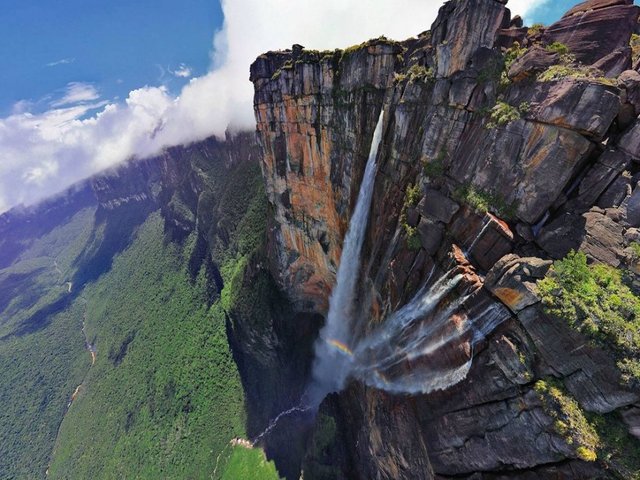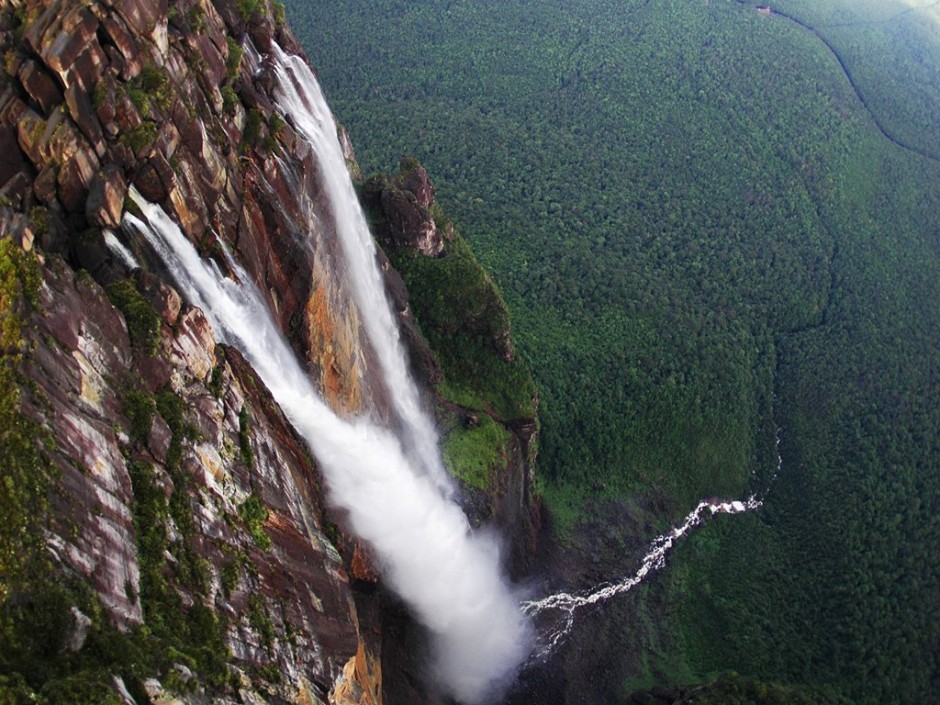
THE ANGEL FALLS
Angel Falls [Salto Ángel in Spanish] [Pemon : Kerepakupai Meru meaning "waterfall of the deepest place", or Parakupá Vená, meaning "the fall from the highest point"] is a waterfall in Venezuela.
It is the world's highest uninterrupted waterfall, with a height of 979 meters [3,212 ft] and a plunge of 807 meters (2,648 ft). The waterfall drops over the edge of the Auyán-tepui mountain in the Canaima National Park, a UNESCO World Heritage site in the Gran Sabana region of Bolívar State. The height figure 979 metres (3,212 ft) mostly consists of the main plunge but also includes about 400 metres (0.25 mi) of sloped cascade and rapids below the drop and a 30-metre (98 ft) high plunge downstream of the talus rapids.
The falls are along a fork of the Rio Kerepacupai Meru which flows into the Churun River, a tributary of the Carrao River, itself a tributary of the Orinoco River.
The waterfall has been known as the "Angel Falls" since the mid-20th century. They are named after Jimmie Angel, a US aviator, who was the first person to fly over the falls. Angel's ashes were scattered over the falls on 2 July 1960.
The common Spanish name Salto del Ángel was derives from his surname. In 2009, President Hugo Chávez announced his intention to change the name to the purported original indigenous Pemon term ("Kerepakupai Vená", meaning "waterfall of the deepest place"), on the grounds that the nation's most famous landmark should bear an indigenous name. Explaining the name change, Chávez was reported to have said, "This is ours, long before Angel ever arrived there ... this is indigenous property." However, he later said that he would not decree the change of name, but only was defendingthe use of Kerepakupai Vená.Sir Walter Raleigh in his expedition to find the fabled city of El Dorado described what was possibly a tepuy (table top mountain), and he is said to have been the first European to view Angel Falls. Some historians state that the first European to visit the waterfall was "Fernando de Berrío", a Spanish explorer and governor from the 16th and 17th centuries. Other sources state that the first westerner to see the waterfall was Spanish explorer "Fèlix Cardona" in 1927.

According to accounts of Venezuelan explorer Ernesto Sánchez La Cruz, he spotted the falls in 1912, but he did not publicize his discovery. Cruz possibly saw the Montoya Falls in the Sierra Pacaraima region, which are more than 500 metres [1,600 ft] tall. They were not known to the outside world until American aviator [Jimmie Angel], following directions given by the explorer Fèlix Cardona who had seen the waterfall six years before, flew over them on 16 November 1933 on a flight while he was searching for a valuable ore bed.
Returning on 9 October 1937, Angel tried to land his Flamingo monoplane El Río Caroní atop Auyán-tepui, but the plane was damaged when the wheels sank into the marshy ground. Angel and his three companions, including his wife Marie, were forced to descend the tepui on foot. It took them 11 days to make their way back to civilization by the gradually sloping back side, but news of their adventure spread and the waterfall was named Angel Falls in his honor. The name of the waterfall—"Salto del Ángel"—was first published on a Venezuelan government map in December 1939.
Angel's plane remained on top of the tepui for 33 years before being lifted out by helicopter. It was restored at the Aviation Museum in Maracay and now sits outdoors on the front of the airport at Ciudad Bolívar.
The first recorded person of European descent to reach the base of the falls was Latvian explorer "Aleksandrs Laime", also known as "Alejandro Laime" to the native Pemon tribe. He reached the falls alone in 1946. He was the first to reach the upper side of falls in the late 1950s, by climbing on the back side where the slope is not vertical. He also reached Angel's plane 18 years after the crash landing. On 18 November 1955, Latvian independence day, he announced to Venezuelan newspaper El Nacional that this stream without any known local name should be called after a Latvian river, Gauja. The same year, this name was registered in the "National Cartographic Institution of Venezuela". There are no convincing proofs that indigenous Pemon people had named the local streams, as Auyán-tepui was considered to be a dangerous place and was not visited by the indigenous people. However, lately the Pemon name Kerep is used as well.
Laime was also the first to clear a trail that leads from the Churun River to the base of the falls. On the way is a viewpoint commonly used to capture the falls in photographs. It is named Mirador Laime ["Laime's Viewpoint" in Spanish] in his honor. This trail is used now mostly for tourists, to lead them from the Isla Ratón camp to the small clearing.
The official height of the falls was determined by a survey carried out by an expedition organized and financed by American journalist Ruth Robertson on 13 May 1949. Robertson's expedition, which began on April 23, 1949, was also the first to reach the foot of the falls. The first known attempt to climb the face of the cliff was made in 1968 during the wet season. It failed because of slippery rock. In 1969, a second attempt was made during the dry season. This attempt was thwarted by lack of water and an overhang 120 metres [400 ft] from the top. The first climb to the top of the cliff was completed on 13 January 1971. The climbers required nine and a half days to ascend and one and a half days to rappel downAngel Falls is one of Venezuela's top tourist attractions, though a trip to the falls is a complicated affair. The falls are located in an isolated jungle. A flight from Puerto Ordaz or Ciudad Bolívar is required to reach Canaima camp, the starting point for river trips to the base of the falls. River trips generally take place from June to December, when the rivers are deep enough for use by the Pemon guides. During the dry season (December to March) there is less water seen than in the other months. The falls receive roughly 900,000 visitors per year.
Angel Falls also inspired the setting of the Disney animated film Up (2009) although, in the film, the location was called Paradise Falls instead of Angel Falls. It also makes a small appearance in the Disney film Dinosaur, as well as the 1990 film Arachnophobia. Most recently, it makes an appearance in the 2015 film Point Break. Numerous documentaries have covered the falls, including Planet Earth.
Hi! I am a robot. I just upvoted you! I found similar content that readers might be interested in:
https://en.wikipedia.org/wiki/Angel_Falls
Downvoting a post can decrease pending rewards and make it less visible. Common reasons:
Submit